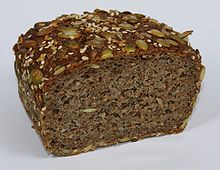



Multigrain bread is a type of bread prepared with two or more types of grain.[1] Grains used include barley, flax, millet, oats, wheat, and whole-wheat flour,[2][3] among others. Some varieties include edible seeds in their preparation,[4] such as flaxseed, quinoa, pumpkin seeds, and sunflower seeds.[3][5] Rye and sourdough multigrain breads are additional varieties.[4][6][7] Preparations include 7-grain and 9-grain bread,[8] among others.
Multigrain bread may be prepared using whole, unprocessed grains,[9] although commercial varieties do not necessarily always contain whole grains.[1]
Whole grain multigrain breads contain a dietary fibre content of up to four times greater than white breads[4][10] and may also contain more vitamins and protein compared to white bread.[11] Multigrain breads also provide complex carbohydrates.[12]
Multigrain bread is commercially mass-produced and marketed to consumers.[13] Some commercial varieties are prepared using 100% whole grain flour.[13] Between 1989 and 1994 in the United States, multigrain bread was "one of the fastest growing markets within the bakery sector".[14]
A 4,000-year-old Mesopotamian recipe for brewing beer from multigrain loaves of bread mixed with honey is the oldest surviving beer recipe in the world.[15] The Brussels Beer Project microbrewery in Belgium has developed an amber beer with a 7% alcohol by volume named Babylone that incorporates this recipe using leftover, unsold fresh bread donated by supermarkets.[15][16][17]